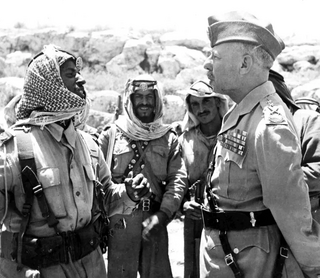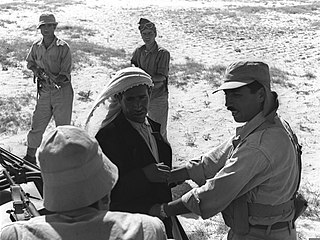
The 1948 Arab–Israeli War, also known as the First Arab–Israeli War, followed the civil war in Mandatory Palestine as the second and final stage of the 1948 Palestine war. The civil war became a war of separate states with the Israeli Declaration of Independence on 14 May 1948, the end of the British Mandate for Palestine at midnight, and the entry of a military coalition of Arab states into the territory of Mandatory Palestine the following morning. The war formally ended with the 1949 Armistice Agreements which established the Green Line.
This timeline of the Israeli–Palestinian conflict lists events from 1948 to the present. The Israeli–Palestinian conflict emerged from intercommunal conflict in Mandatory Palestine between Palestinian Jews and Arabs, often described as the background to the Israeli–Palestinian conflict. The conflict in its modern phase evolved since the declaration of the State of Israel on May 14, 1948 and consequent intervention of Arab armies on behalf of the Palestinian Arabs.
This page is a partial listing of incidents of violence in the Israeli-Palestinian conflict in 2003.
The history of the Israel Defense Forces (IDF) intertwines in its early stages with history of the Haganah.
This page is a partial listing of incidents of violence in the Israeli-Palestinian conflict in 2004.

The Avivim school bus bombing was a terrorist attack on an Israeli school bus on 22 May 1970, in which 12 civilians were killed, nine of them children, and 25 were wounded, one of whom died of a wound sustained in the attack 44 years later. The attack took place on the road to Moshav Avivim, near Israel's border with Lebanon. Two rocket-propelled grenades were fired at the bus. The attack was one of the first carried out by the PFLP-GC.

Palestinian return to Israel refers to the movement of Palestinians back into the territory of present Israel.

The Ras Burqa massacre was a mass shooting on 5 October 1985 on Israeli vacationers in Ras Burqa, a beach resort area in the Sinai peninsula, in which seven people, including four children, were killed by Egyptian soldier Suleiman Khater.

Palestinian fedayeen are militants or guerrillas of a nationalist orientation from among the Palestinian people. Most Palestinians consider the fedayeen to be freedom fighters, while most Israelis consider them to be terrorists.
The following is a partial list of civilian casualties in the Second Intifada.
Events in the year 1956 in Israel.
Events in the year 1955 in Israel.
The Yehud attack was an attack on a civilian house in the village of Yehud carried out by a Palestinian fedayeen squad on 12 October 1953. Three Israeli Jewish civilians, a mother and her infant children, were killed in the attack.
The Ein Ofarim killings was an attack by Palestinian Fedayeen, which occurred on Wednesday night, 12 September 1956.

The 2006 Gaza cross-border raid, known by Palestinian militants as Operation Dispersive Illusion was an armed incursion carried out by seven or eight Gazan Palestinian militants on 25 June 2006 who attacked Israel Defense Forces (IDF) positions near the Kerem Shalom Crossing through an attack tunnel. In the attack, two IDF soldiers and two Palestinian militants were killed, four IDF soldiers were wounded, one of whom was Gilad Shalit, who was captured and taken to the Gaza Strip.
The Misgav Am hostage crisis, which began during the night of April 7, 1980, was a raid carried out by a squad of five Palestinian militants belonging to the Iraqi-backed Arab Liberation Front militant organization, on the northern Israeli kibbutz of Misgav Am in which the militants captured a group of toddlers and babies in the children's sleeping quarters of the kibbutz and held them as hostages. The event ended the next day with the takeover of the terrorist stronghold by Israeli special forces.
The murder of the Aroyo children was a terrorist attack which occurred on 2 January 1971, in which two Israeli children were killed when Palestinian militants threw a hand grenade into the moving car of the Aroyo family which was touring the Gaza Strip. The attack was a turning point in the way Israel began relating towards terrorist threats originating from the Gaza Strip. Following the attack Israel launched an extensive counter-terror operation in the Gaza Strip.
The August 2012 Sinai attack occurred on 5 August 2012, when armed men ambushed an Egyptian military base in the Sinai Peninsula, killing 16 soldiers and stealing two armored cars, which they used to infiltrate into Israel. The attackers broke through the Kerem Shalom border crossing to Israel, where one of the vehicles exploded. They then engaged in a firefight with soldiers of the Israel Defense Forces (IDF), during which six of the attackers were killed. No Israelis were injured.
September 2012 southern Israel cross-border attack refers to an incident on 21 September 2012, when three Egyptian militants, wearing civilian clothes and armed with explosive belts, AK-47 rifles and RPG launchers, approached the Egypt-Israel border in an area where the Egypt–Israel barrier was incomplete, and opened fire on a group of IDF soldiers supervising the civilian workers who were constructing the border fence.






